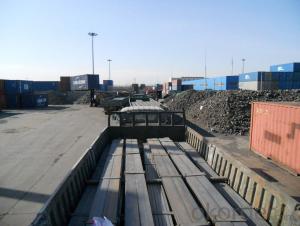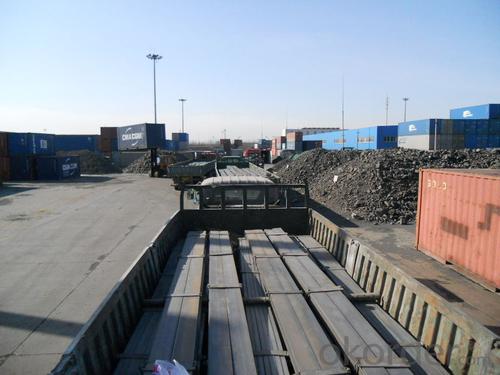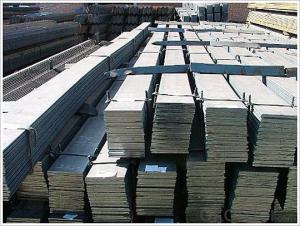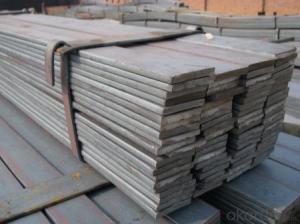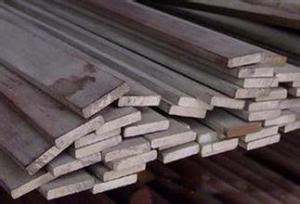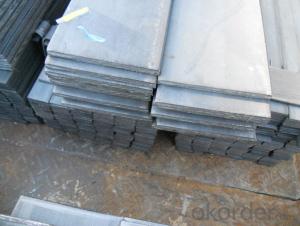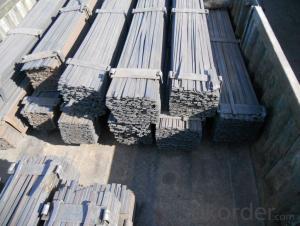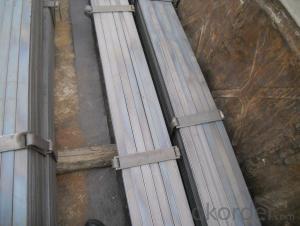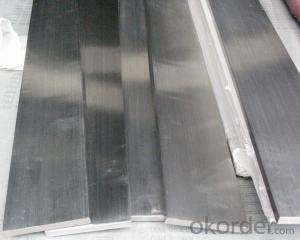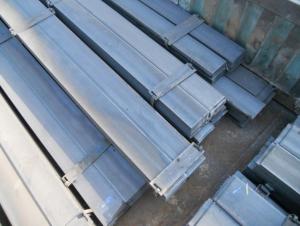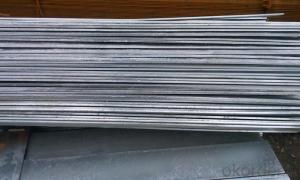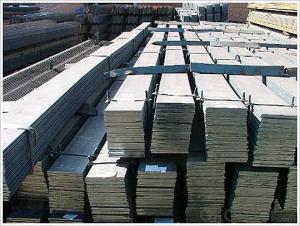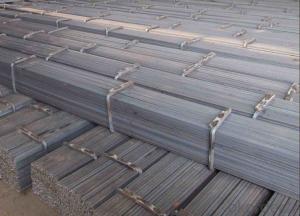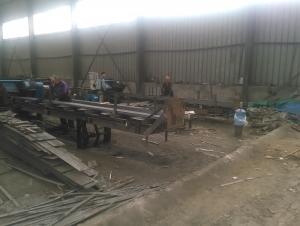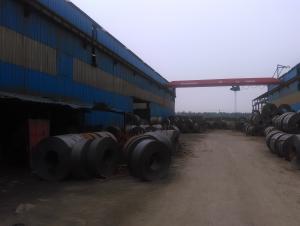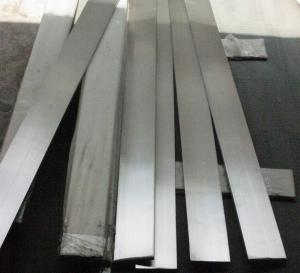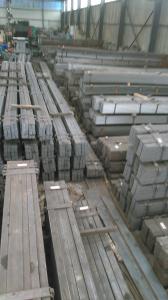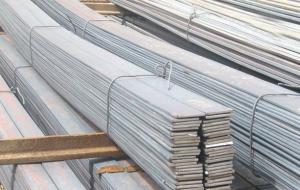Supply Steel Flat; Flat Steel Bars with High Quality
- Loading Port:
- Tianjin
- Payment Terms:
- TT or LC
- Min Order Qty:
- 3000 m.t.
- Supply Capability:
- 10000 m.t./month
OKorder Service Pledge
OKorder Financial Service
You Might Also Like
Product Description:
Spring Steel can be divided into two types. One is carbon spring steel, and other one is alloy spring steel.
Alloy spring steel is based on carbon spring steel, by adding one or more alloying elements to improve the mechanical properties, hardenability and other properties to meet the requirement for manufacturing all kinds of spring steel.
Specification of Spring Steel:
-Material: 70Si2CrA
-Production: Hot rolled or cold rolled
-Standard: GB/T·5218-1999
-Type: Spring Steel
-Alloy or no: Alloy
Mechanical Properties:
-Annealing Condition:
1, Tensile Strength: σb/MPa:≤835
2, Elongation: δ/%:≥8
-Quencher condition:
1, Tensile strength: σb/MPa:785~1175
2, Elongation: -
Usage/Applications of Spring Steel:
For manufacturing all kinds of flat spring or round spring with small sections, clockwork spring,
Packaging & Delivery of Spring Steel:
-Packing Detail: The products can be packed in bundles by steel wires.
-Marks:
1, Tag marks: the tag marks will be tied up to each bundle of the products. The information is usually including supplier’s logo and name, product name, made in China, products’ specifications, the painted color and other information requested by customers.
2, Color marks: we will paint both ends of the bundles of these products to make sure that they are more evident. It’s will be more convenient for the customers to distinguish them at the destination port.
-Delivery Detail:
1, Delivery time: 30~45 working days after receive buyer’s T.T. or L/C.
2, Delivery status should be written in the contract. (Heat treatment or no)
FAQ:
Q1: Why buy Materials & Equipment from OKorder.com?
A1: All products offered byOKorder.com are carefully selected from China's most reliable manufacturing enterprises. Through its ISO certifications, OKorder.com adheres to the highest standards and a commitment to supply chain safety and customer satisfaction.
Q2: How do we guarantee the quality of our products?
A2: We have established an advanced quality management system which conducts strict quality tests at every step, from raw materials to the final product. At the same time, we provide extensive follow-up service assurances as required.
Q3: How soon can we receive the product after purchase?
A3: Within three days of placing an order, we will begin production. The specific shipping date is dependent upon international and government factors, but is typically 7 to 10 workdays.
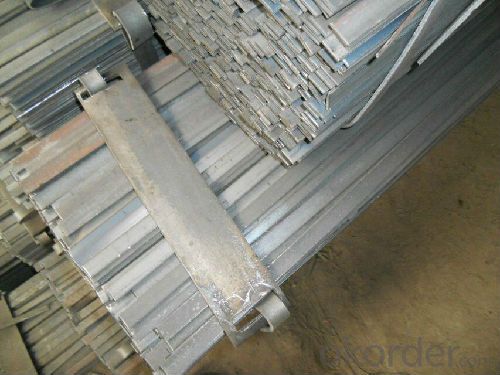
- Q: The distinction between flat steel and steel strip
- The first is to use cyanide cyanide salt, it is commonly referred to as the "cyanide", it is the metal surface while being carbon atoms and nitrogen in a chemical heat treatment process of saturated (cyanide containing carbon, nitrogen, assuming the metal is a, valence +n, cyanide formula a (CN) n).
- Q: How do steel flat bars compare in terms of strength and durability?
- Steel flat bars are known for their exceptional strength and durability. They are one of the strongest and most durable materials available in the construction industry. Compared to other materials like wood or aluminum, steel flat bars possess a significantly higher strength-to-weight ratio, making them an ideal choice in applications where structural integrity is of utmost importance. The strength of steel flat bars is derived from their composition and manufacturing process. Steel is an alloy composed primarily of iron and carbon, with trace amounts of other elements. The carbon content in steel determines its strength, with higher carbon content resulting in greater strength. Additionally, the manufacturing process of steel flat bars involves hot rolling, cold rolling, or extrusion, which further enhances their strength by aligning the grains of the steel. In terms of durability, steel flat bars are highly resistant to corrosion, weathering, and wear. This is due to their inherent properties, as well as various protective coatings that can be applied to the surface of the bars, such as galvanization or painting. These coatings provide an additional layer of protection against rust and other forms of deterioration, ensuring the longevity and durability of steel flat bars in various environments. Furthermore, steel flat bars are capable of withstanding heavy loads, impacts, and extreme temperatures without compromising their structural integrity. This makes them suitable for a wide range of applications, including construction, manufacturing, transportation, and infrastructure projects. In conclusion, steel flat bars excel in terms of strength and durability when compared to other materials. Their high strength-to-weight ratio, resistance to corrosion and wear, and ability to withstand heavy loads and extreme conditions make them a reliable and long-lasting choice for various applications.
- Q: What are the common welding methods used for steel flat bars?
- The common welding methods used for steel flat bars are MIG (Metal Inert Gas) welding, TIG (Tungsten Inert Gas) welding, and stick welding (Shielded Metal Arc Welding).
- Q: Can steel flat bars be used in food processing applications?
- Yes, steel flat bars can be used in food processing applications. Steel is a common material choice in the food industry due to its durability, strength, and resistance to corrosion. Flat bars made of stainless steel are particularly suitable for food processing applications as they are non-reactive and do not leach any harmful substances into the food. Stainless steel flat bars are also easy to clean and maintain, making them a hygienic choice for food processing equipment and surfaces. Additionally, steel flat bars can be easily fabricated and shaped to meet the specific requirements of food processing applications, making them a versatile option in this industry.
- Q: Can steel flat bars be used for fencing or gate fabrication?
- Yes, steel flat bars can be used for fencing or gate fabrication. Steel flat bars are commonly used in fencing and gate projects because of their durability, strength, and versatility. They can be easily welded or bolted together to create a strong and secure fencing or gate structure. Additionally, steel flat bars can be customized to meet specific design requirements, making them a popular choice for both residential and commercial fencing and gate applications.
- Q: Can steel flat bars be used for making brackets or supports for agricultural machinery?
- Yes, steel flat bars can be used for making brackets or supports for agricultural machinery. Steel is a durable and strong material, making it suitable for providing the necessary support and stability required in agricultural machinery. Additionally, steel is resistant to corrosion, which is crucial in agricultural environments that are often exposed to moisture and harsh weather conditions.
- Q: Can steel flat bars be used in automotive manufacturing?
- Yes, steel flat bars can be used in automotive manufacturing. Steel flat bars are commonly used in various applications within the automotive industry due to their strength, durability, and versatility. They can be used in the fabrication of various automotive components, such as brackets, supports, frames, hinges, and reinforcements. Steel flat bars offer excellent structural integrity and can withstand heavy loads, making them suitable for use in automotive manufacturing. Additionally, steel is a cost-effective material and readily available, making it a popular choice in the automotive industry.
- Q: What is the difference between carbon steel and stainless steel flat bars?
- The main difference between carbon steel and stainless steel flat bars lies in their composition and properties. Carbon steel flat bars are primarily made of iron and carbon, with a maximum carbon content of 2.1%. This makes them strong and durable, but they are not resistant to corrosion. On the other hand, stainless steel flat bars contain a high percentage of chromium (at least 10.5%) along with iron and other elements. This chromium content forms a protective layer on the surface of the steel, making it highly resistant to corrosion and rust. Due to its corrosion resistance, stainless steel flat bars are commonly used in applications where exposure to moisture or chemicals is a concern, such as in marine environments or the food industry. Carbon steel flat bars, on the other hand, are often used in applications where strength and durability are the primary requirements, such as construction and manufacturing. Another notable difference is the appearance. Carbon steel flat bars have a dull gray finish, while stainless steel flat bars have a shiny, reflective surface. This aesthetic difference can be a factor in certain applications where appearance matters, such as architectural or decorative purposes. In summary, the key differences between carbon steel and stainless steel flat bars are their corrosion resistance, composition, and appearance. Carbon steel is strong and durable but prone to corrosion, while stainless steel is highly resistant to corrosion and offers a shiny finish. The choice between the two depends on the specific requirements of the application at hand.
- Q: How do steel flat bars behave under high temperatures?
- Steel flat bars behave differently under high temperatures depending on the type of steel and the specific temperature range. In general, steel has a high melting point and is known for its ability to withstand heat. However, when exposed to extremely high temperatures, steel flat bars may undergo certain changes in properties. At temperatures below the steel's melting point, the flat bars will typically retain their shape and strength. They may expand slightly due to thermal expansion, but this is usually minimal and does not significantly affect their structural integrity. Steel is known for its excellent thermal conductivity, which allows it to transfer heat away from the hot areas, minimizing the risk of deformation or failure. As the temperature continues to rise, steel can begin to lose its strength and become softer. This process, known as tempering, occurs due to the rearrangement of the steel's crystal structure. It is important to note that the exact temperature at which tempering occurs depends on the specific type of steel. For instance, low carbon steels will start to soften at relatively lower temperatures compared to high carbon steels. If the temperature reaches a critical point, known as the austenitizing temperature, steel undergoes a phase transformation and becomes austenitic. At this stage, the steel becomes highly malleable and can be easily shaped. However, it also loses its strength and hardness, making it more prone to deformation and failure. Additionally, prolonged exposure to high temperatures can cause steel flat bars to experience oxidation, leading to the formation of rust. This can further weaken the steel and compromise its structural integrity. In summary, steel flat bars generally behave well under high temperatures up to their melting point. They retain their shape and strength, with minimal expansion. However, beyond certain temperature thresholds, steel can begin to soften or even undergo phase transformations, leading to reduced strength and increased susceptibility to deformation. Therefore, it is crucial to consider the specific type of steel and its temperature limitations when exposed to high temperatures.
- Q: What is the maximum length of steel flat bars available?
- Manufacturers and suppliers can offer steel flat bars with varying maximum lengths. Generally, standard lengths for these bars fall between 20 and 24 feet. It is worth noting that custom orders or specialized uses may allow for longer lengths, albeit at an extra cost or requiring special transportation precautions. Thus, it is advisable to consult the manufacturer or supplier directly to ascertain their specific maximum length of steel flat bars.
Send your message to us
Supply Steel Flat; Flat Steel Bars with High Quality
- Loading Port:
- Tianjin
- Payment Terms:
- TT or LC
- Min Order Qty:
- 3000 m.t.
- Supply Capability:
- 10000 m.t./month
OKorder Service Pledge
OKorder Financial Service
Similar products
Hot products
Hot Searches
Related keywords
